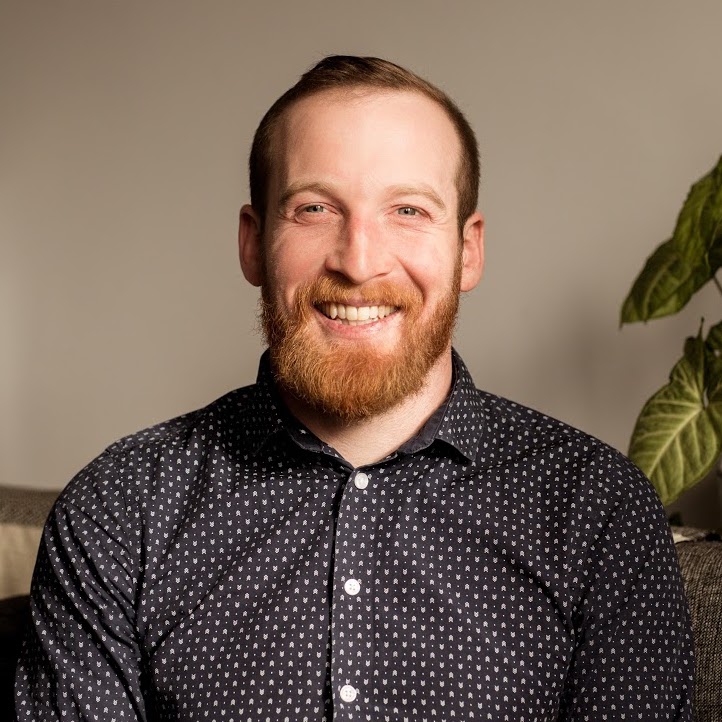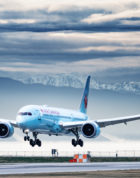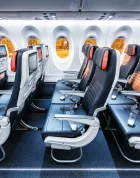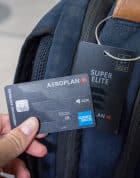The primary motivation for our trip to Nepal was to head into the Himalayas for a trek.
This time, our destination was Langtang National Park, one of the trekking areas that’s relatively close to Kathmandu.
We had an outstanding time, and in this article, I’ll share some insight into our week-long journey into the Himalayas.
In This Post
- Booking Our Langtang Trek
- Day One: Getting There Is Half the Fun
- Day Two: Turn Right for Langtang, Left for Tibet
- Day Three: Yaks Want Momos, Too
- Day Four: Surrounded by Giants
- Day Five: Ups and Downs
- Day Six: David Attenborough Was Right… Sorta
- Day Seven: A Change of Plans
- Conclusion
Booking Our Langtang Trek
When it comes to booking a trek in Nepal, you’re absolutely spoiled with choice, and no matter which trek you choose, you’re bound to have an epic experience.
My wife Ashley and I had been talking about coming to Nepal together ever since I returned from my visit there in 2008.
During the dark and wet months of the latter part of 2022 at our home on Vancouver Island, we watched Aftershock: Everest and the Nepal Earthquake on Netflix. One of the regions highlighted in the film is the Langtang Valley, which got us talking about our travel plans for 2023.
We were captivated by the stories of the locals’ resilience in the face of disaster, and were also awestruck by the natural beauty portrayed in the film.
My good friend Neil has the enviable task of leading trips to this part of Nepal as part of his work, and his stories and pictures had also inspired me to visit the area at some point, too.
After some discussion, we set our sights on a week-long (or so) trek in the Langtang Valley for April 2023. This is one of the better times of the year for trekking in the area, which also happened to coincide nicely with some time that we had planned to take off from work.
We also chose this particular trek due to its relatively close proximity to Kathmandu. We didn’t have a lot of time to spend unplugged in the mountains, and since it was Ashley’s first time doing a trek, we thought that a week-long test would be a better idea than going all-in on a three-week slog into high altitudes.
After sketching out some dates, I reached out to my friend Mr. Thakur Raj Pandey of First Environmental Trekking in Kathmandu. He helped to arrange our trek in 2008, and we’ve stayed in touch over the years, as I’d long wanted to return to Nepal.
He also happens to be the Senior Vice President of the Nepal Trekking Association, and I trusted him and his staff to look after our trekking arrangements this time around.
Following a few back-and-forth emails about itineraries, dates, and pricing, we committed to the trip.
Mr. Pandey greeted us at the airport with a very warm welcome, and dropped us off at the Kathmandu Marriott Hotel after our arrival.
When we returned to his office to settle our bill, meet our guide Ngima, and finalize the details, I was pleased to see that a picture I’d sent to him of our trekking group from 15 years ago was still placed amongst many below the glass cover of his desk.
As I sipped on my first cup of masala chai during our meeting, I felt nostalgic for my last visit to the country, and excited about the adventures ahead.
Included in our trek, which cost $235 (USD) per person at the time, were the following:
- Trekking permits
- Round-trip transportation by bus
- Our guide, including his transportation, meals, insurance, and lodging
- Trekkers’ Information Management System (TIMS) card
We were on the hook for our meals, lodging, gear, and insurance; however, it’s worth noting that many outfitters can work with you to have these included, too. To pay for these, we popped by an ATM to stock up on cash, and we were able to cover the main part of our trek with a credit card.
Before long, we had everything set up, and arranged to depart a couple of days later. Until then, it was time to explore the city, adjust to the time difference, and bid farewell to the digital universe.
Day One: Getting There Is Half the Fun
On the eve of our departure, we took extra time to ensure we had all of the gear we were supposed to, and gleefully powered down our laptops.
In the morning, we left around 9am after a casual stroll through the city, enjoying what would likely be our last cappuccino and hot shower for a while.
Our guide, Ngima Sherpa, met us at our hotel, and helped us load our gear into the jeep. We’d opted to upgrade to a private transfer for around $100 (USD), as I’d been on public buses in Nepal before, and hoped for some more comfort at the beginning of our trek.
Driving in Nepal is almost as much of an adventure as doing anything in the mountains.
Our jeep navigated through stop-and-go traffic in Kathmandu, and once we’d left the smog clouds behind, we began on a road that snaked around a valley. There happened to be a major construction project happening, and it took us a couple of hours to make it just 20km.
From there, the traffic thinned out, and our driver used some impressive manoeuvres to get us ahead of others travelling in the same direction.
We eventually turned off the main highway, and started making our way up a large hillside. At this point, the road started to narrow, and we snaked our way upwards through tiny terraced villages.
Road shoulders soon became a thing of the past, and looking out over the side usually resulted in your stomach dropping, as it was a long way down with nothing much to break your fall.
As we gained altitude, the road narrowed, and we were jostled and tossed back and forth in the jeep along patches of road that were paved, bumpy, or ones that seemed to have been blasted out of a cliffside earlier that day.
Following a checkpoint, we passed through a townsite, before making our way down a slow and windy road to Syabrubesi, our destination for the day. It took us around six hours to travel around 150km.
After a relaxing meal on the patio of our guesthouse, we walked around the village, played some soccer with local children, and headed back to rest up for our trek.
We fell asleep to the sounds of festive cheers from a group of Italian trekkers who had just wrapped up their journey and were enjoying some beers together.
Day Two: Turn Right for Langtang, Left for Tibet
Our jetlagged bodies were up at 4am, and we spent the morning hydrating, repacking our bags, and feeling energized by our first cold shower.
As we sipped on coffee and masala chai, we watched a drove of donkeys get loaded up with supplies, while the Italian group, looking a bit worse for wear, loaded up into a bus back to Kathmandu.
After fuelling up with an omelette and momos, delicious dumplings that are a hallmark of Nepal, we hit the trails for an early start to the day around 7:30am.
As we left Syabrubesi, we hit a fork in the road, and Ngima told us that if we turned left, we’d head to Tibet, and that turning right would take us to the Langtang.
The first 4km followed along a road beside the Langtang Khola (river), and we were accompanied by a herd of goats for part of this leg. It was peaceful to hear rushing water and see the river’s beautiful blue hue, and we also caught our first glimpse of a monkey swinging from the trees.
As we made our way onto a trail, we trekked through bamboo jungles and rhododendron forests. In April, we were fortunate to have flowers blooming all around us, which served as a good distraction from the physical exertion and the hot temperatures.
I took note of a sign for a hot spring as we crossed a river bed, which apparently David Attenborough himself had visited during a trek to the area.
As we made our way along the trail, the value of having a guide (which is now mandatory for all trekkers) became immediately apparent. Ngima would often stop us to point out an animal hiding in the bushes, a beehive on a cliff (that I thought was moss), or when to fill up our water bottles.
He also shared with us stories of other treks he’s done in Nepal, as well as Sherpa culture and what it was like to grow up in the Himalayas.
After a heavy climb through the jungle following lunch, which included our first suspension bridge and some epic scenery, we arrived at Lama Hotel, our destination for the day.
We paid around $10 (CAD) for a night in Room 7, which was fairly rustic. A sheet of plywood and some fabric separated us from Room 6 to the left, while some thin boards were all that separated us from our neighbours in Room 8.
At this point, we were a far cry from the comforts of hotels, although we opted to pay an extra dollar to enjoy a “hot” shower while we still could.
I mostly slept soundly that night, despite waking up in the middle of the night to pitch-black darkness and the sound of rushing water in the background.
Day Three: Yaks Want Momos, Too
In the morning, I enjoyed a cup of chai while warming up in front of the stove in the guesthouse’s kitchen. In between sips, the pressure cooker on the stove, which was cooking dal, let out loud blasts of steam.
In the corner of the room, I noticed that several of the family members who run the guesthouse were fast asleep, soaking in a few extra moments of shuteye before another busy day of hosting guests. This was one of my favourite parts of teahouse trekking in Nepal, as you’re often a guest in people’s homes, rather than simply a guest at a lodge.
With another busy day ahead of us, we packed up after breakfast and began the day’s climb. Our legs were sore, but not exhausted, and our heavier-than-they-needed-to-be packs hadn’t yet caused too much discomfort in our shoulders, backs, and hips.
We encountered many waterfalls, steep hills with switchback trails, and pops of colour with blooming rhododendrons as we slowly made our way up in altitude.
The trail flattened out after lunch, and we passed across a plateau that appeared to have been partially buried in rubble.
Ngima stopped us here, and explained that this was one of the many former townsites in the area which had been wiped out during the earthquake in 2015. It was a particularly poignant moment, as we reflected on how devastating the earthquake was in this region, and how many people were still buried underneath.
We stopped for lunch in the next village, and quietly enjoyed a bowl of sherpa stew and dal bhat.
My wife Ashley hadn’t slept well the night before, so we decided to play it by ear and alter our plans accordingly. We settled for the day in Thyangshap, which was short of our goal, but Ashley was wiped and not feeling well.
Ngima kept a close eye on her, as we were high enough at this point where altitude sickness started to become more of a concern. That morning, we had breakfast with a South African trekker who had to be evacuated from the Everest region with bad altitude sickness, and her story made us even more mindful of the symptoms.
As Ashley rested, I explored the village, and wound up watching the local yaks graze for the latter part of the day. In the distance, we caught our first glimpses of 7,000+ metre peaks, which I hoped we’d get to see close.
Ngima and I had a good laugh when a yak stood at the entrance to the dining room, seemingly hungry for an order of momos or two. The fire in the dining room was fuelled with yak dung, and Ngima entertained my numerous questions about these glorious, burly creatures.
Before long, it was off to bed to rest up for a big push the next day.
Day Four: Surrounded by Giants
Despite not sleeping well, Ashley was feeling up to continuing onward the next day. After a hearty breakfast that included yak yogurt, yak cheese, veggie momos, and coffee, we left Thyangshap motivated by the towering peaks in the distance.
Along the way, we passed by the former Langtang townsite, which had also been buried in rubble. In the new village, we stopped by a monastery with a memorial to the locals and trekkers who were killed in the earthquake.
An older Tibetan man showed us how to spin the prayer wheels, which made a tinny sound as they whirled around.
At lunch, we enjoyed some seabuckthorn juice and some ginger tea, before we started on the final push for the day.
The views only became more epic with each step, as we followed a riverbed with a slow gain in altitude. One turn led into a gorgeous valley, and we found ourselves surrounded by 7,000–8,000+ metre giants.
Beneath my breath, I couldn’t stop uttering “Wow!” as we laid eyes on some famous Himalayan peaks in the area. I also opted to stop and observe yaks with a greater frequency than Ashley and Ngima cared to.
In Kyanjin Gompa, our pitstop for the night, we enjoyed a quiet afternoon exploring the area and enjoying the views from the scenic town. There are also plenty of yaks around, which I made sure to follow.
On our way into town, I couldn’t help but get excited about maybe enjoying a suite upgrade and free breakfast when we passed a sign for the Himalayan Hilton, but alas, it was just clever marketing.
During dinner, as we enjoyed some chow mein with yak cheese an the local specialty dhindo, I looked at the various t-shirts and pictures that other trekking groups had left behind following the successful completion of their journey.
Kyanjin Gompa is both a destination and a starting-off point for mountaineers seeking to summit some of the world’s tallest mountains. While I don’t count myself in that category of adventurer, it was fascinating to see how many people came here in search of adventure.
We were perfectly content with this being our main destination; however, for others, it’s merely a starting point.
We tucked ourselves in early that night, in preparation for a big day ahead.
Day Five: Ups and Downs
Ngima and I met for a quick breakfast of Tibetan bread with honey and jam at the crack of dawn. Ashley had another broken sleep, but was otherwise feeling fine, and opted to stay back at the teahouse while we attempted an “easy” summit.
We followed a lineup of headlamps zig-zagging up a hill just outside the townsite. At one point Ngima zigged where everyone else had zagged, and I assumed he knew of a better route to get to our destination.
As I lumbered up the mountain, while Ngima’s stride was more of a casual stroll, I questioned the accuracy of my GPS watch, which showed that we’d already surpassed our target altitude. When I asked Ngima if this was the case, he chuckled and let me know that everyone else was heading to a false peak, but we were headed to the true peak.
I trusted his judgment, and followed in his footsteps as we eventually made our way up to Kyanjin Ri peak at 4,770 metres.
Sure enough, we could see a cluster of trekkers celebrating down at the false peak, while we had what felt like the entire Langtang Valley to ourselves.
Ngima pointed out all of the peaks and their altitudes. In the distance, we could clearly see Shishapangma in Tibet, which towers at 8,027 metres, and closer to us were Langtang Lirung (7,234 metres), Yala Peak (5,500 metres), and Tsangbu Ri (6,781 metres).
After throughly soaking in the moment, we started to make our way down to the false peak, and joined the larger group in amazement as the roar of an avalanche across the valley echoed around us.
We returned to Kyanjin Gompa on a high, and celebrated the day by enjoying a cappuccino with Ashley, who was feeling a bit more rested.
Before long, we began our way back down the valley, with a long slog ahead of us.
In the notes I took on my phone, I have the word “brutal” written multiple times to describe the mental and physical challenges I experienced for the rest of the day. Surely, I’d overpacked for the trip, and various parts of my body were burning with fatigue.
Ngima and Ashley must have heard some language that was about as colourful as the rhododendron blooms we passed through, but we kept each other in good spirits until we reached our destination village.
Our host family warmly greeted us, and I quaffed down some sips of warm beer after putting on some dry clothes and taking some time to stretch.
We slept soundly that night, our bodies in need of some rest and coming down from the highs of the day.
Day Six: David Attenborough Was Right… Sorta
The next morning, my legs felt a bit rusty, but the aches wore off after the first 15 minutes or so. I also motivated myself with the prospect of a soak in the hot springs later that day.
We followed our footsteps down the valley and through forests, with air that was noticeably warmer and thicker than when we passed through a few days prior.
In Bamboo, we dropped our bags down, and I swiftly ordered a cold beer and got my bathing suit and towel ready for the hot springs.
After traipsing across a rickety bridge, we were disappointed to find that the rag that served as the stopper for the hot springs had been pulled, and soaking wasn’t going to be an option right away.
Following lunch, we returned to find a few inches of hot water pooled, which was enough to begin a soak. After a few moments of bliss, we realized that some local animals had used the hot spring pool as an outhouse, which could have been why it was emptied.
While it was a bit disappointing, I decided to give the pool a clean and then filled it up for the next group of would-be bathing enthusiasts. The family at the nearby guesthouse where we had lunch gave me a bucket, which I used to pour hot springs water over my aching muscles until I’d had my fill.
I don’t know if I felt like I was 21 again, as David Attenborough claimed, but I still felt refreshed and ready to tackle the next hill.
Our final mission that day was to hike up to Thulo Syabru, which we could see perched way up on a hillside. We followed what seemed to be neverending switchbacks, until we stopped to rest at a tea shop at the top of the hill.
We followed rolling hills until we crossed a long suspension bridge with remarkably low railings, and then made our way up to the village alongside steep cliffsides with no guardrails.
Thulo Syabru is a gorgeous village, set on various tiers of a terraced hillside. We dropped our packs down at Namaste Guesthouse, and got to know the family who runs it over the course of the evening.
A local toured us around a gorgeous monastery, and showed us a massive prayer wheel located nearby, before we headed back to rest up for the evening.
Day Seven: A Change of Plans
In the morning, Ngima forecasted our tentative plan for the next couple of days over breakfast. If we pushed it, we could make our way to Gosaikunda, a stunning alpine lake, and visit a yak cheese factory, before we needed to head back to the city a couple of days later.
This would require a relatively significant effort in terms of altitude gain and loss in a short amount of time. The other option was a more leisurely wind-down to the trek, and heading back to the city a day early.
Ashley and I deliberated the options, and ultimately decided to venture back to Kathmandu early to visit a couple more places before we left for India a few days later.
Ngima went along with our request, and planned our trails accordingly.
While we felt a bit of disappointment about cutting our trek short this time, the previous week had been more than fulfilling, and we also discussed returning to the area to do a different trek at some point in the future.
Compared to the previous days, our trek out was much less remarkable. We followed trails and roads until we reached a village with a bus stop.
After a quiet lunch, we hopped on a local bus to Dhunche, which was our final stop before heading back to Kathmandu the next day.
Instead of a private transfer or a local bus, we decided for a “local jeep” to get us back to the city. I wasn’t quite sure what this meant, but we eventually learned that it was the same as a private transfer in an SUV, except that there were more bodies inside than there were seatbelts.
I can’t say that this was the most relaxing or comfortable way to travel, especially since our driver managed to find bumpy gravel roads all the way back to Kathmandu. Much to my surprise, we arrived back in the city safely, and hopped in a taxi back to our hotel.
Ngima presented us with scarves from his home region to commemorate the successful completion of the trek, and we exchanged contact information and left him with a tip before a gloriously hot shower and a trip to the spa.
Conclusion
My wife Ashley and I spent a week in the Langtang National Park in Nepal on a trek. While it was certainly both mentally and physically challenging at times, it was well worth the time, effort, and money, and we’d both go back to Nepal without hesitation.
Nepal is a fascinating country with so much to offer, and if you’re considering a trip there, using Miles & Points for flights and hotels will free up your budget for mountain adventures.
I hope this insight into our experience is helpful to anyone who’s planning a trip to the Langtang, and if you’d like to hear more, feel free to catch up with me at the next Prince of Travel event.




















